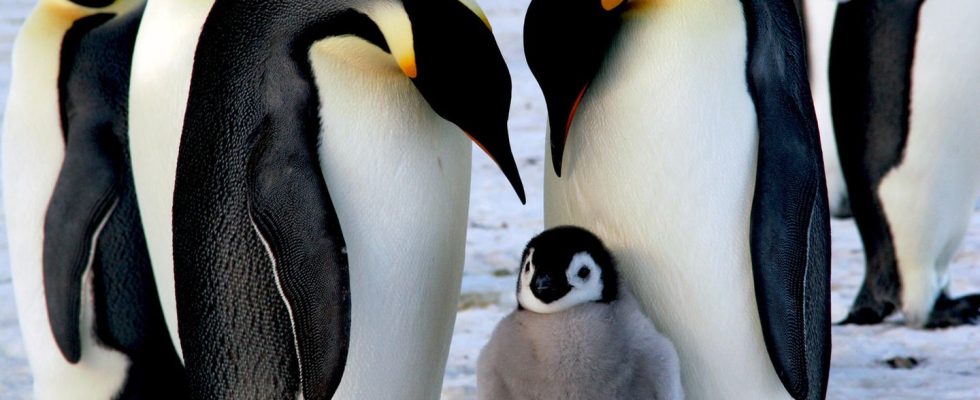Researchers have detected the deadly form of bird flu in eternal ice for the first time. They fear a catastrophe for wildlife. In addition to penguins, they also care about other creatures.
Now it’s official: The bird flu virus has been detected on the Antarctic mainland, the kingdom of the penguins. The news is shocking, but comes as little surprise: researchers had been predicting exactly this scenario for months, which could have fatal consequences for biodiversity.
After the virus first spread in Europe and North America, it raged in South Africa and finally in South America in October 2022. From there, all that was needed was seabirds to carry the pathogen to Antarctica.
Finally, a few days ago, researchers at a British Antarctic Survey station on Bird Island found some sick skuas, a type of seagull, and giant petrels. Scientists sent samples back to the UK for testing. “They were actually positive,” says Norman Ratcliffe, a seabird ecologist with the British Antarctic Survey.
Mass extinction of animal species is a real danger
The virus, known as H5N1, was previously confirmed in gentoo penguins found dead on Sea Lion Island in the Falkland Islands, a British territory.
For researchers, the threat of mass extinction has become a real danger. In addition to rare penguins, up to 100 million seabirds are said to have their breeding grounds there, but seal species such as Weddell seals and leopard seals also live here.
“On some of the Antarctic and sub-Antarctic islands there are species that are only found on these islands, and only in small numbers, in the hundreds or thousands,” said Thijs Kuiken of Erasmus University Rotterdam in the Netherlands. “If the virus reaches these populations, they are at risk of extinction.”
Penguins have low immunity
Before H5N1 appeared here, highly pathogenic avian influenza viruses had never been detected in this area. This means that the penguins and all the other animals probably have little immunity. Because they breed in large, densely packed colonies, the virus can probably spread quickly. Which in the worst case scenario could cause mass extinction. This was also the case in South America last year, when Chile reported the deaths of thousands of Humboldt penguins.
In Antarctica, the situation is made worse by the fact that many penguins are already threatened with extinction as rising temperatures are dwindling the sea ice that the animals need for nutrition, reproduction and defense.
In addition, the pathogen has adapted better to its environment and has therefore become even more dangerous. It has spread from birds to mammals several times and has affected, for example, elephant seals and other marine mammals that gather on the coast. Almost 30 species have been affected so far. This includes stray cats and dogs as well as foxes, tigers and leopards. In January, a polar bear with the H5N1 bird flu virus was discovered in Alaska for the first time.
New Zealand is also now worried about biodiversity
The virus of the currently predominant line H5N1 first appeared in 1996 in a poultry farmer in the southern Chinese province of Guandong. Almost two decades later, there is hardly an area on earth that has not been affected. Because with the Antarctic discovery, the last bastion is now shaking: Australia and Oceania.
People in New Zealand are already preparing for their arrival. “We don’t know exactly how HPAI (highly pathogenic avian influenza viruses) affect native species, but it is more likely that colony-nesting birds or animals that interact with these birds are affected during periods of close contact,” says Bruce McKinlay from the University of Otago in New Zealand. Non-breeding collections of waterbirds that stay in wetlands or at flood roosting sites are also potentially at risk.
“In a few species, vaccination during outbreaks could be an effective way to protect a captive breeding population and prevent the species from going extinct,” McKinlay said. However, it is not possible to vaccinate all endangered birds. The focus would probably have to be on captive species that can receive the full two doses of the vaccine.
Bird flu vaccinations are being tested
New Zealand researchers are currently conducting a study on the safety and effectiveness of vaccination against bird flu for five critically endangered native species.
In Germany, the responsible authorities are preparing the use of vaccines in poultry in a federal-state working group, according to the Friedrich Löffler Institute in Greifswald.
There is still no suitable, regularly approved vaccine available against currently circulating viruses. Last year, however, two recombinant vaccines were tested in chickens. No virus excretion after contact with the pathogen was observed in any of the vaccinated animals. Since these vaccines cannot be used in waterfowl, two additional vaccines have also been successfully tested in ducks.

